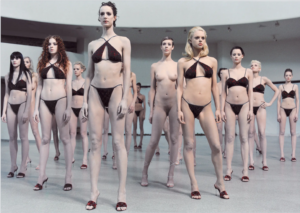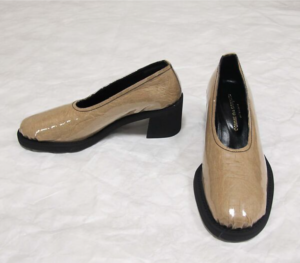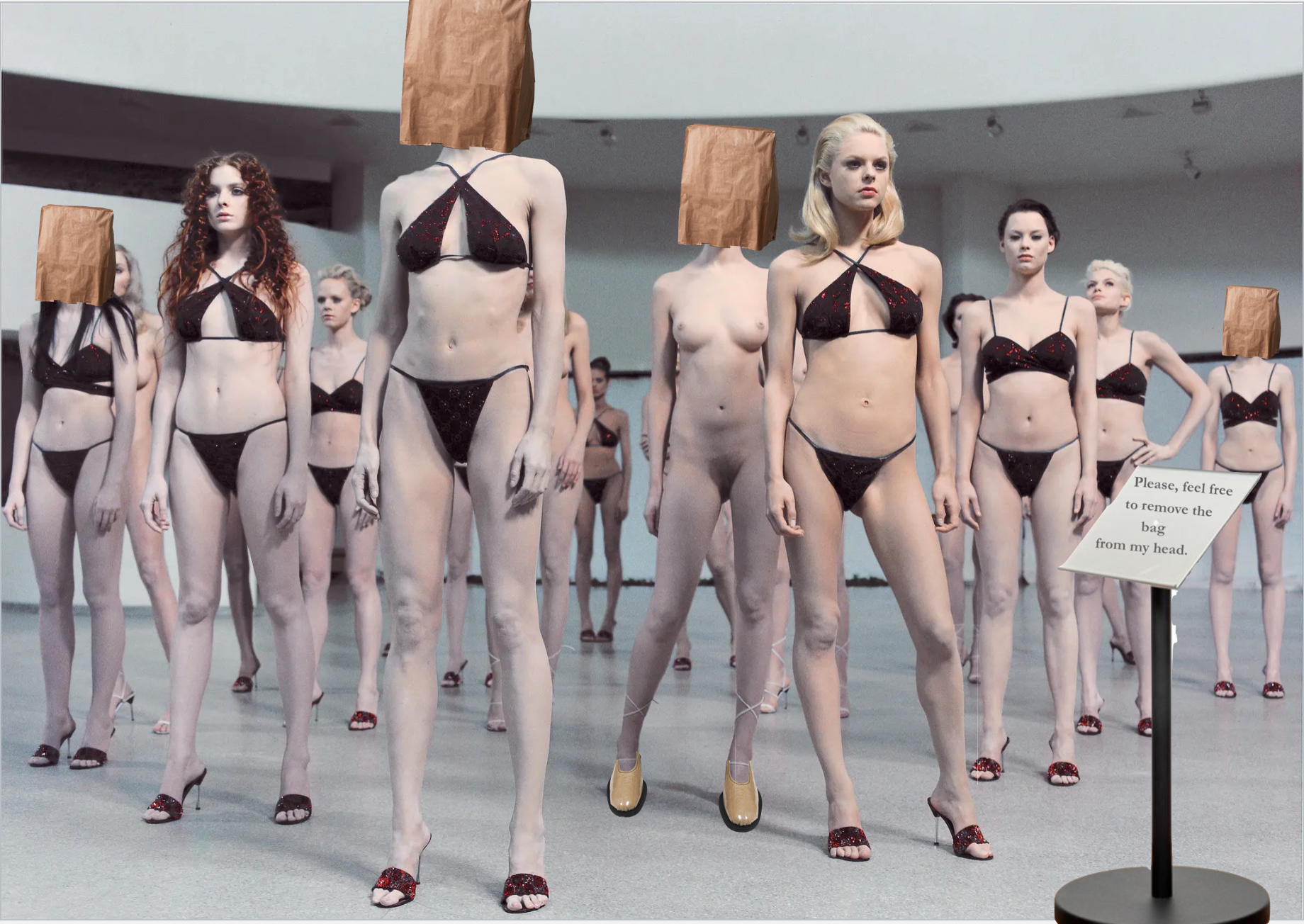“Please, Feel Free to Remove the Bag From My Head.”
“Self-respect is a discipline, a habit of mind that can never be faked but can be developed, trained, coaxed forth. It was once suggested to me that, as an antidote to crying, I put my head in a paper bag … It is difficult in the extreme to continue fancying oneself Cathy in Wuthering Heights with one’s head in a FoodFair bag.”
Joan Didion, “On Self-Respect”

Photo by Vanessa Beecroft

Comme Des Garçons AW15, Rei Kawakubo. This image is property of the Metropolitan Museum of Art. Reference “Ensemble” in the citations for complete attribution.
by Isabel Max
The shoes I chose to feature in my artwork look pieced together. The up-close viewer is hyper aware of how the crinkled brown paper is separate from deliberate black stitching and clear plastic covering, which is ruffled at the toe as it has been tucked to fit the shape of an imposing, chunky black sole. The raw materials give the impression that they are not far from their original state, as if the thread is on a spool and the paper is on a roll, except that they have been rough-cut to make room for the foot of the wearer. Comme Des Garçons founder and Tokyo-based designer Rei Kawakubo’s autumn/winter 2015 collection, “Ceremony of Separation,” which the shoes come from, has been interpreted as an expression of “the fragility of life and the finality of death,” (“Ensemble”). For the complete look, Kawakubo paired these shoes with a lacy three-piece ensemble, which comes with care instructions that warn of the materials’ predisposition to fraying, catching, fading and peeling. While the ensemble was perhaps Kawakubo’s focus and more laborious of an endeavor, I think the shoes alone force the viewer to appreciate the labor that went into them: We can see in them their genesis and while looking at the final product, we can imagine, without difficulty, the human effort that made up its construction. One contradiction to this otherwise apparent process is the texture of the brown paper. While the cutting, stitching and folding all contribute to the ability to wear the shoe, the wrinkles in the paper serve an ornamental purpose. It raises the question of where the wrinkles come from. Has the paper been affected, perhaps, by something outside of the shoe making process? Like an aging body, maybe the wrinkles came over time and repeated use. Indeed, the tone of the paper is similar to skin. It is more shocking, then, to wonder if the paper was crushed suddenly, with angry purpose or simply perceived as a waste. Both instances suggest that the paper lived a life that would mutate it in the end. Kawakubo’s interest in the “fragility of life,” imbues her choice of paper in otherwise practical footwear. That the paper is covered in plastic, which both strengthens and preserves it, could be a nod to death–or, more specifically, the backward-looking perception of a whole, lived life. The paper can no longer be smoothed or crumpled. It is petrified in a final state. The materials around the paper encase it like an artifact, and do the work of a museum to care for this fragile, historied piece.
The high heel of the shoe genders the object. Kawakubo’s shoe, personified, is a woman. There is history, contradiction and paradox in the notion of a woman’s life as a fragile one. Regardless of arguments for and against that idea, gender is a pervasive, lifelong authority. It is either visible or assumed, never absent in people. Gender, especially the female kind, is still something that people feel obliged to pin down and stitch into place. Vanessa Beecroft’s image and installation of a group of fair-skinned female models contemplates the objectification of women. The women are, importantly, pretty in conventional standards and they are presented in a museum, among artifacts. I superimposed Kawakubo’s shoes onto a model who is naked, but for the shoes and a (superimposed) brown paper bag over her head. She is surrounded by other models who are scarcely clothed, some of whom, in my variation, wear paper bags, too. Instead of the new context further gendering the Kawakubo’s shoes, they are juxtaposed with the strappy stilettos of the other models. In the image, Kawakubo’s shoes look clunky, practical and masculine. They do the work of bringing out the fragility––and discomfort––of the shoes around them. The models wearing the stilettos are partaking in a painful balancing act that wants for sturdier ground. They are laborers. Unless a woman is giving birth, “labor” is a word historically used for a man’s effort. These models keep that trained, foreboding expression that exudes confidence and sex, which, after standing for hours in heels, is still expected as much as it is impressive. Just like Kawakubo’s shoes’ evidence of labor takes away from the idea of a seamless femininity, a sign of exhaustion on the models’ faces would give ground to the idea of them as laboring, and take away from their allure as feminine, sexy and mysterious beings.
The paper bag I superimposed on some of the models’ heads is a continuation of the material and meaning of the Comme Des Garçons shoes and the result of inspiration derived from the Joan Didion essay, “On Self-Respect.”
“Self-respect is a discipline, a habit of mind that can never be faked but can be developed, trained, coaxed forth. It was once suggested to me that, as an antidote to crying, I put my head in a paper bag … It is difficult in the extreme to continue fancying oneself Cathy in Wuthering Heights with one’s head in a FoodFair bag.”
Though it is a satirical example, Didion maintains that small disciplines like this one form a “ritual” of self-respect that help us “remember who and what we are.” Paper bags on the heads of the Vanessa Beecroft models complicate this idea. The difference between who and what the women are is enlarged by their role as museum artifacts. This tension can be felt when looking at the image. It is disconcerting to think of the paper bags in my image as a practice of self-respect because there is a discombobulation of power between model, museum goer, and viewer. At once, we could feel like we can relate to all three.
If we are the museum goer, we are met with a sign that reads “Please, feel free to remove the bag from my head.” Though it could be similar to one, calling this set-up a “social experiment” would be going too far. If the museum were to record actions taken by the visitors, there likely would be more non-responses than responses. What I wonder about more deeply is how the museum-goer’s discomfort translates to hesitation. My focus on the internal experience is part of what confirms that the adapted installation intends to be art rather than experimentation. It is an uneasy feeling that, as a visitor to the museum, we could remove the bag from the model’s head. We are trained not to touch artifacts. Even though the sign asks us to “feel free,” this adds to our discomfort rather than assuaging it. Some silent alarm in us is unconvinced we should act freely. We tend to be uncomfortable with the uncovering of things that are not our own. Uncovering is sensual. It is vulnerable for both the covered and the unveiler. That the sign is written in first person establishes that the head belongs to the independent body, rather than to the installation. For example, the sign just as easily could tell the viewer to remove the bag from “a head.” As the museum goer, we are aware that the prospect of removing the bag would be a personal interaction. In hesitating from doing so, are we protecting ourselves? Or the model? Both? The model can’t see us approaching, but we may become hyperaware of our approach, our body movement toward the artifact or exactly how we remove the bag–carefully, maybe, and determined not to make direct contact with the model’s skin. While most people probably shy away from interacting with the model, why is it so easy to imagine that the daring visitor is young and male and white? In this speculation, the boy is empowered by his gender association and–an extension of that–his laughing friends. The boy would remove the bag as a price he pays to boost his own image, to assert his masculinity. The scene is funny to the boys because it is at the same time public and sensual. In a masculine world, the public must overpower the private. Despite his effort to transcend the vulnerable with his bravery, a personal choice arises–one that perhaps wasn’t anticipated in his approach: What will he do with the bag? Is it his to keep? There is no clear idea who the bag belongs to, whether it is a viable souvenir or the property of the model, of the artist or the museum. Once the bag is taken off the head of the model, does it remain a part of the art? Maybe the boy, in removing the bag, becomes a contributing artist. Or, in taking the bag, he becomes part of the art. Is the bag to be respected, or can it be trashed? Placed over a different head? These questions of ownership are a symbol of a woman’s life, which asks the muddy, persistent question of what actually belongs to her, including her image. If the bag is a symbol of self-respect, my art asks whether the woman has full agency over her self-respect when her purpose is divided between a what and a who.
Whichever model’s face is exposed, our perception of her will change. The face is a site of recognition, of empathy, emotion, racism and fetishization. If the face of the Asian woman is exposed, how might the visitors respond? Because the models are likened to museum artifacts, perceptions of the Asian woman may mirror, disturbingly, those of the Roberto Cavalli dress in the MET Museum’s “Blue Willow” room, for example. Anne Cheng describes the paradox of fetishizing Asiatic femininity. Cheng maintains that the beauty of the Cavalli dress, which is reminiscent of a porcelain vase, “comes from the primacy of the object; the human or the anthropomorphic is the incidental alibi for, or afterthought of, relishing this pure objectness. At the same time, however, what renders this pure objectness legible as such is precisely the invocation of (very human) racial difference.” Will the Asian model be seen, first, as human or as object? How does that reaction differ from the reaction of uncovering the face of a white woman?
If a museum-goer removes the bag from a model’s head, will they be adding to, or taking away from her freedom? Before we can answer this question, we must speculate on who (or what) placed the bags on the models’ heads. Our periphery expands as we look at the art when we conjure images of these women existing outside of a museum context. As a viewer of my image, before Didion’s context, we may associate the women with paper bags on their heads with captives, taken out of normal lives and “installed” against their will. If we view the women as captive we invoke their humanness. We are quick to empathize with them. Importantly, we might not ask female captives what we ask of their male counterparts: Are they guilty? Are they dangerous?
If we use Didion’s context, though, the model has placed the bag on her own head, to stop herself from crying. She is willingly engaging in the discipline of self-respect. That image, too, though, is disturbing. The idea that the models are disciplining themselves on top of the strenuous labor of their performance likens them to an ascetic. Didion calls these small, often painful disciplines a “ritual,” which also invokes spirituality. The instinct of the viewer is that the models are, first and foremost, beautiful bodies. That she has substance and individuality under the paper bag–something that transcends her physicality–hidden from view contradicts the idea of the models as objects on display. In other words, it further distances the woman’s identity from how she is perceived. It is unsettling to imagine that this act of self-discipline would take place in public. It is as if the woman would rather be covered or hidden, completely, but the paper bag, as barrier between public and private, will suffice. In this case, the woman has no agency over her physical placement, no emotional investment in the work at hand. In one sense, her head is what belongs to her, alone. Unlike her naked or mostly-naked body, she can keep her head for herself. Both her identity and her expression are hidden. Indeed she could be crying into the bag–not to stop herself from crying, necessarily, but to have the privacy to do so. The pain of her labor as well as the potential of her as captive justifies this response. Similarly, the bag gives the model the opportunity to rest her deliberately empty expression, like those on the faces of the uncovered models around her. At the same time, if we place ourselves in the model’s position, there is an anxiety that fills the air she breathes in the bag. It is the air of the installation, which implies that the bag could be taken off her head at any moment, displaying her face, fixed or formless or “not white,” to the public. It is perhaps safer to avoid remembering oneself as a “who,” and concentrate on one’s presence as a “what.” The anxiety of being uncovered could be powerful enough to dissuade facial expression, completely. The bag, then, and the model’s self-respect, paradoxically represent both the threat of its being taken from her, as much as the protection it offers her.
My art is a commentary on the expectation of a woman as an unremitting sacrifice to her own femininity. She is at once a laborer, a prisoner, and an object of her beauty. She lives a life that asks her to respect herself while it constantly threatens to disrespect her. Can self-respect be achieved without privacy? A woman’s “Ceremony of Separation” is the parting of herself from how she is perceived. She lives a human life, one that is prone to fraying or fading. She is repeatedly used but asked not to show signs of warping. She lives a life that will mutate her in the end but she will be posthumously smoothed over for history’s sake, for the sake of beauty and for the sake of smoothness like silk, porcelain or plastic. Any self-respect she achieves cannot be petrified for evidence of how to be a woman, but her femininity will be.
Citations*
“Ensemble: fall/winter 2015–16 Comme des Garçons Japanese, Rei Kawakubo” The Metropolitan Museum of Art, https://www.metmuseum.org/art/collection/search/701395.
*external sources, outside of class syllabus

